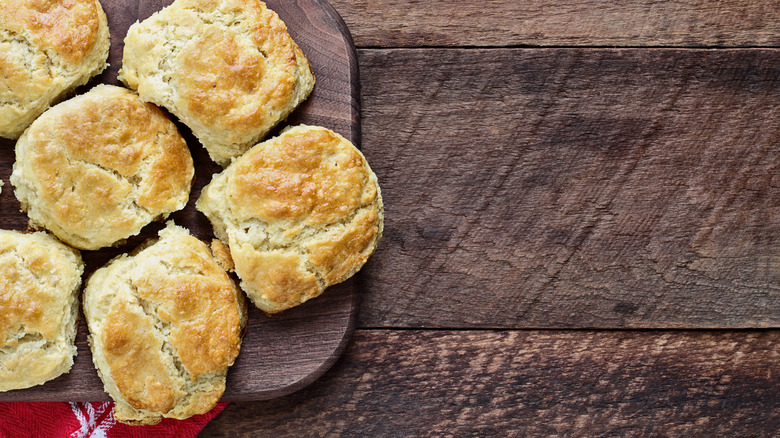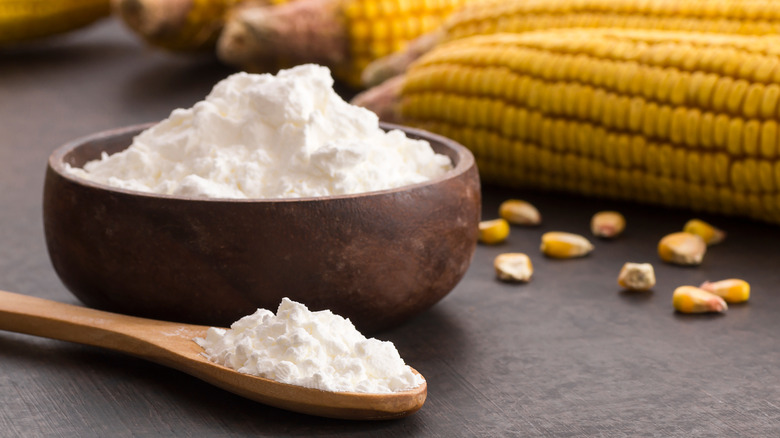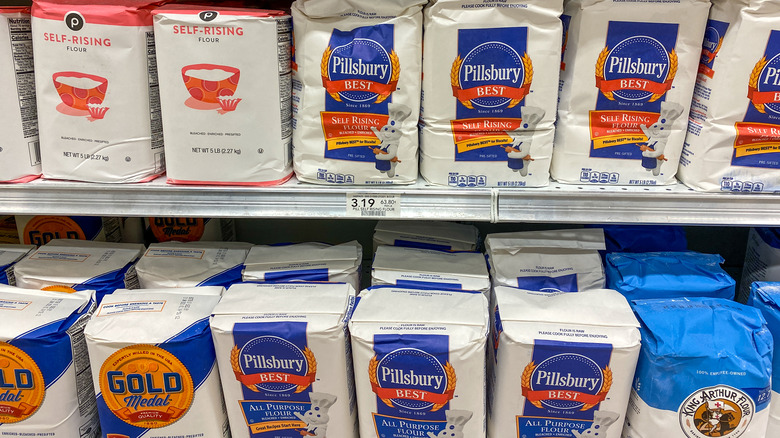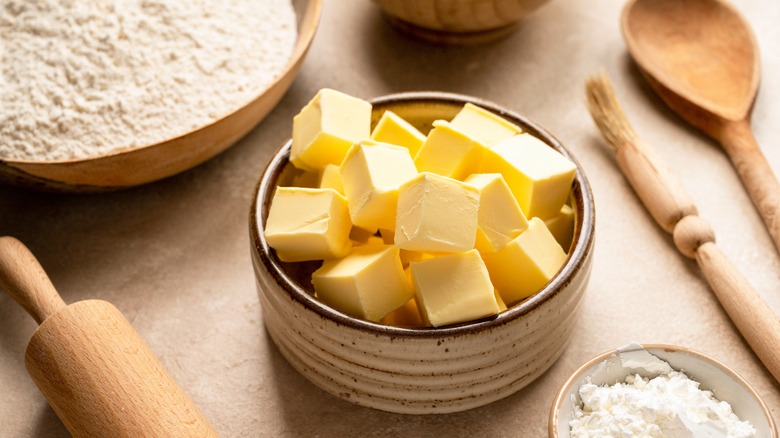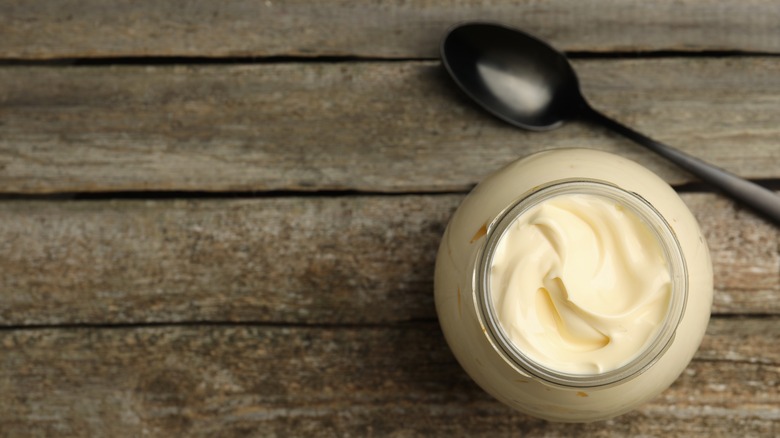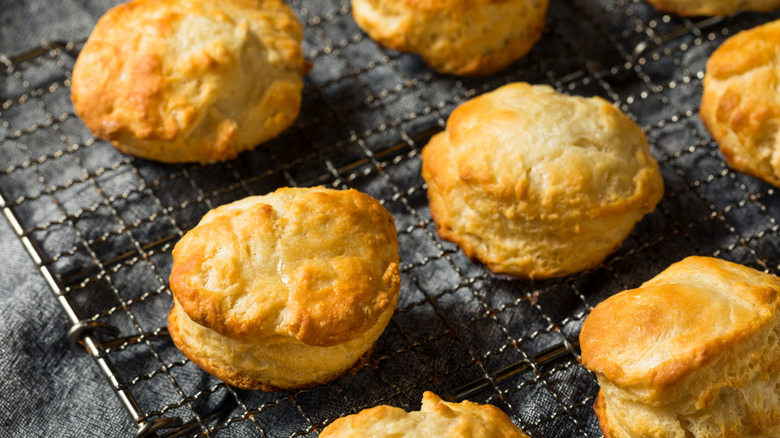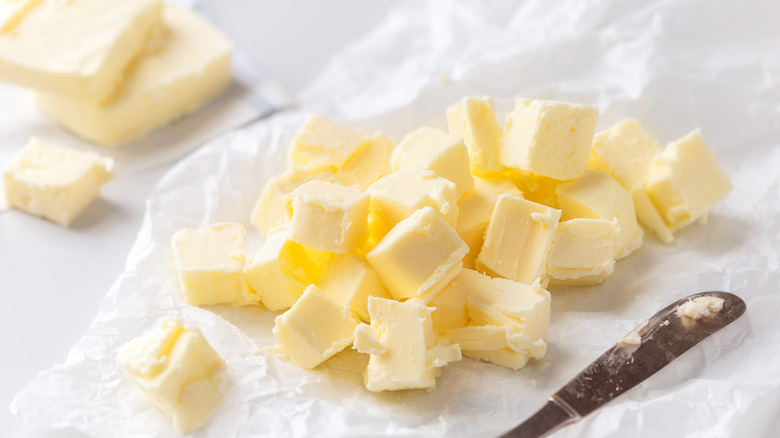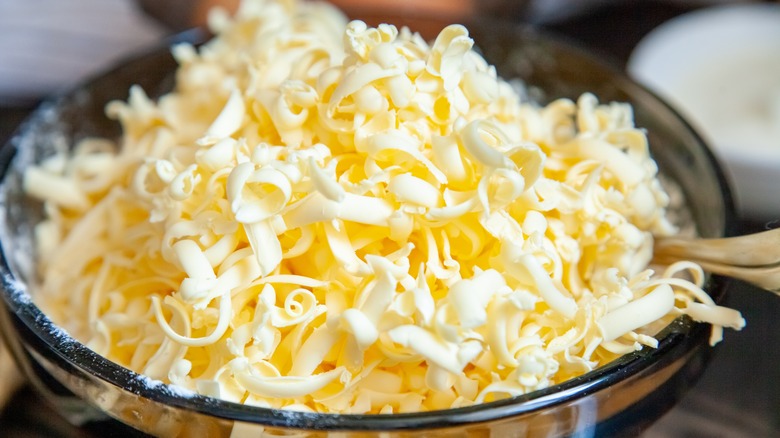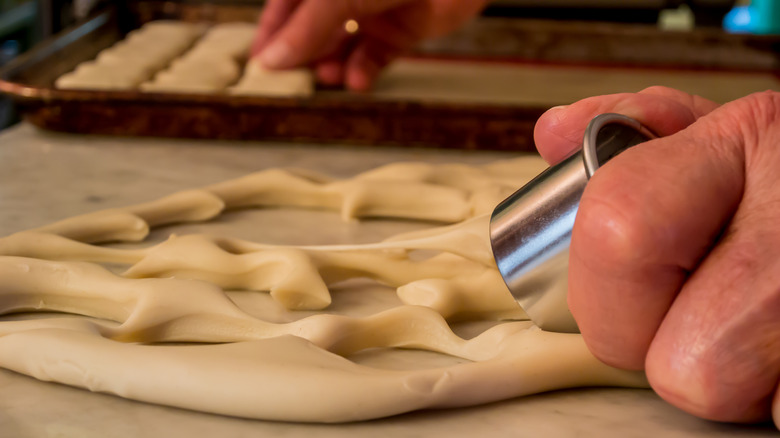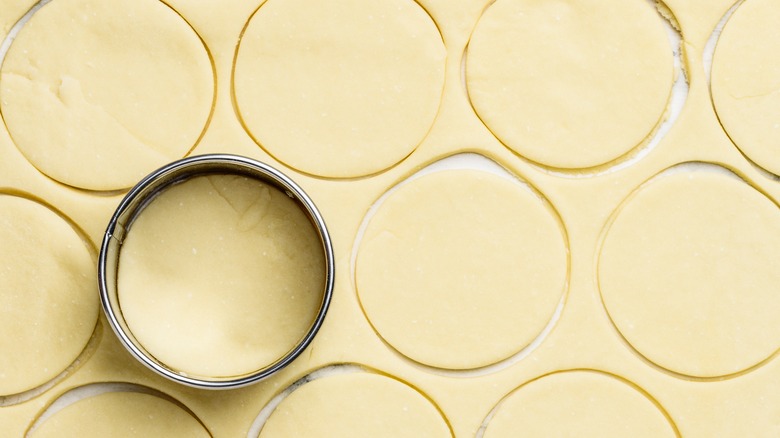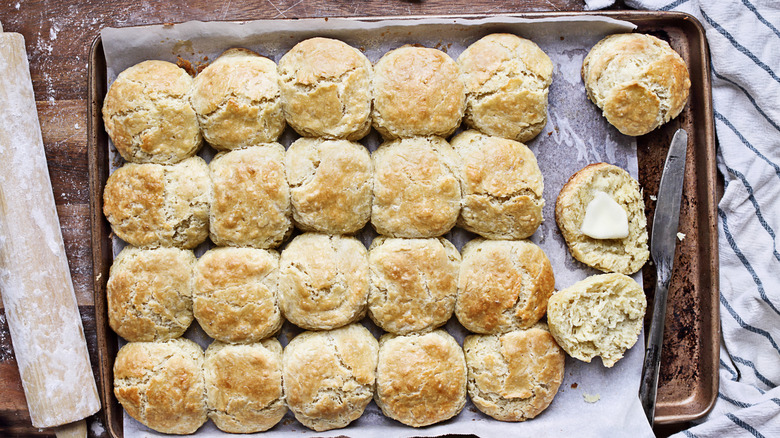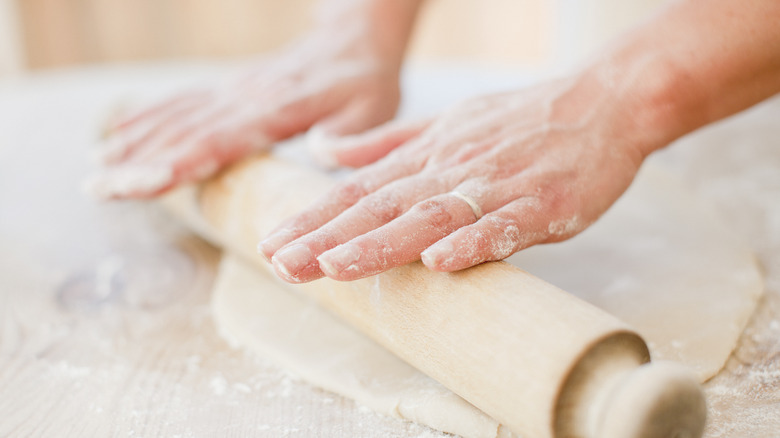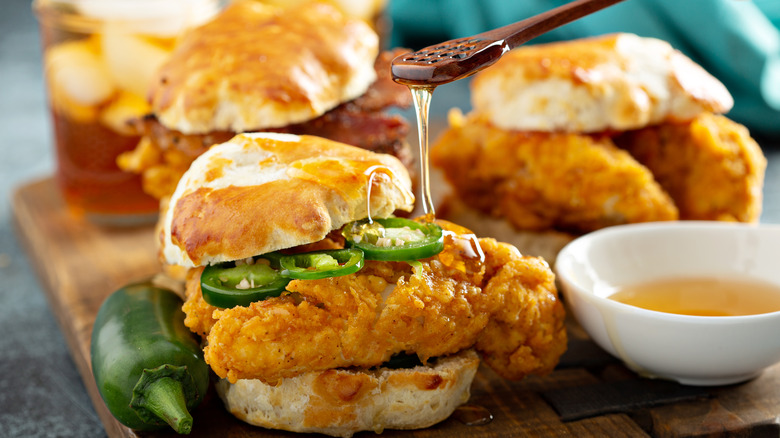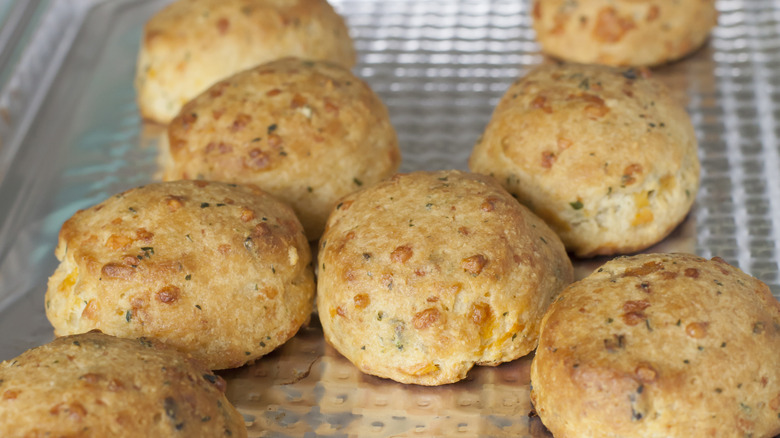15 Biggest Mistakes Everyone Makes When Baking Biscuits
There might not be a more traditional Southern food like biscuits. The word biscuit originates from the French word for "twice cooked" because the original biscuit was baked in a tin before being placed in an oven. The Americanized version of the biscuit appeared in the 1700s, including the beaten biscuit, buttermilk biscuit, and the drop biscuit. The invention of the spring-loaded biscuit cutter by Alexander P. Ashbourne in 1875 revolutionized the speed at which people could cut out biscuit dough and plop it on a baking sheet.
While there have been many modifications to the original Southern biscuit (which was the size of a cat's head, per Texas Chicken and Burgers), the traditional recipe remains the same. Flour, fat, salt, and leavening agents like baking powder are the major players in a delicious biscuit. The biscuit can be dressed up into a decadent breakfast sandwich with eggs and bacon or served as the base for sausage gravy. There are plenty of folks who keep it simple and just stick to butter and a schmear of jam, too.
No matter how you enjoy your biscuits, you still have to master the art of making the perfect biscuit recipe. Here are some of our top tips for making a delicious Southern biscuit — you'll just need to supply all the fixings.
Omitting cornstarch for fluffiness
Our traditional Southern biscuit recipe includes the addition of cornstarch for an added layer of fluffiness in the biscuit dough. While this ingredient is not essential for all biscuit recipes, cornstarch provides a key quality that just about any biscuit benefits from — fluffiness.
Cornstarch, according to Bob's Red Mill, is made from the endosperm of corn. It's regularly used as a thickening agent for sauces and soups and can be used as an anti-caking agent in baked goods. From a scientific angle, adding cornstarch softens the rigid proteins in the flour. Relaxed proteins mean a light, soft structure when you bite into the biscuit. You should plan to add your cornstarch to your other dry ingredients when preparing the dough — there's no need to make a cornstarch slurry. If you don't have cornstarch handy, you can omit this ingredient and replace equal parts with your flour of choice.
Not trying self-rising flour
As its name implies, self-rising flour is different than a traditional all-purpose flour type. In the United States, self-rising flour means that the flour has been enhanced with baking powder and salt, while in Europe, self-rising flour refers to flour with lower protein content. Self-rising flour is a Souther pantry staple, and several Southern recipes use it to replace regular all-purpose flour — like waffles, muffins, hoe cakes, and, of course, biscuits.
If you plan to replace self-rising flour with all-purpose flour in a biscuit recipe, you need to note if any other leavening agents are used. If you plan to keep with the all-purpose flour and add supplemental baking powder, you should use the best quality flour — White Lily. White Lily is the secret to perfectly soft biscuits because it is made of soft winter wheat, which is lower in protein than other conventional flour brands. The slightly lower protein causes the dough to remain a little softer.
Not using enough fat
Fat is the key to making a soft, decadent biscuit. If your biscuits are falling flat, you may need to reflect on both the fat you are using in the recipe as well as how the fat is being allocated throughout the dough. Quaker recommends sticking to a fat with at least 70% fat content. When you're cutting butter into your biscuit dough, you should also make sure your fat is cut into tiny pieces rather than shredded into small specks that can create air pockets in your biscuits rather than layers of butter that give the biscuit its classic flake.
There are many options when it comes to fats in biscuits, per the King Arthur Baking Company. The main difference between lard, shortening, coconut oil, and butter, is the presence of sugars. Butter, unlike the other pure-fat options, contains milk solids. These sugars caramelize as the biscuit cooks and result in a beautiful golden brown color that the other pure-fat options simply won't offer.t
Skipping mayonnaise for moisture
Mayonnaise is the Swiss army knife of cooking. While you can use the egg-and-oil-based ingredient for adding body to chicken salad or as a topping on your favorite burger, you can also use mayonnaise to add moisture and tang to your biscuit recipe. The vinegar in the mayonnaise acts as a tenderizing agent for the proteins in the flour, which creates a decadent crumb. Mayonnaise also helps keep the shape of the biscuits so you can easily spoon and drop the dough on a baking sheet rather than going through the arduous process of rolling out the biscuits and cutting rounds to bake. You might think of it as a condiment first, but mayo is the secret ingredient that will change your homemade biscuits forever.
You can combine self-rising flour, mayonnaise, and milk together for biscuits for a quick drop biscuit. The self-rising flour includes the baking powder needed for rising while the mayonnaise keeps the biscuit moist. If you want to keep the mayonnaise train going, top your finished biscuit breakfast sandwiches with a schmear of homemade garlic aioli.
Discounting the power of buttermilk
Buttermilk is an unexpected ingredient for many culinary applications — but not biscuits. Buttermilk is a byproduct of making butter that has a flavor similar to tangy yogurt but with a consistency thicker than regular milk. Buttermilk began appearing in biscuit recipes in the mid-1900s when Church & Co. (soon to be known as Arm & Hammer) released baking soda into the market. But, since baking soda needed an acid to kick off the leavening reaction, the recipes consulted buttermilk to help kickstart the reaction. Buttermilk can help you make the best biscuits because it's an important tenderizer, which means that adding it to your biscuits helps create the perfect crumbly texture.
While you can make your own buttermilk at home, you should opt for store-bought buttermilk if you plan on using it in your biscuit recipe. The store-bought stuff is thicker and tangier than homemade buttermilk.
Not using butter at the right temperature
Getting the perfect temperature with butter is very important — especially when baking a layered treat like a biscuit. You should tend towards cold butter to make biscuits at home because you want to trap in the moisture from the butter as the biscuit cooks. If the butter is too warm and melted, it will combine with the other drier ingredients and not produce the same rise. Plus, melted butter coats the flour particles in the recipe and inhibits gluten development (via Milk Street). This means the dough won't be elastic and will be much tougher to mix and shape.
Milk Street recommends using frozen butter over cold, room temperature, or melted butter. The flecks of frozen butter are more likely to remain intact than room temperature butter. You can add a couple sticks of butter in your freezer the night before you plan to make biscuits for an easy butter experience.
Skipping grating your fat
When you're making homemade biscuits, using a grater to break your fat into tiny pieces can be a useful hack. This tip is especially important when you are using frozen fat that even the toughest of food processors would have a hard time shredding. When you use a box grater or a handheld grater for this technique, you'll find a better distribution of fat throughout the biscuit dough. When the fat melts, it will produce steam pockets that force the biscuit to rise.
When the fat is in smaller pieces throughout the dough, you'll find that the dough doesn't need to be handled as much as if there were larger chunks of butter in the dough. Over-handling (either by a machine or a baker's hands) is one of the worst things for a finicky biscuit dough because it changes the gluten development. You'll know your butter is the perfect size when you can see tiny flecks interspersed throughout the dough.
Using a stand mixer to combine your ingredients
Stand mixers are, with no doubt, the workhorses of the kitchen. You can use your stand mixer on everything from cookie dough to making bread, and — biscuits? Well, no. You should refrain from using your stand mixer to make biscuit dough because of the potential to over-mix dough.
Instead of using a stand mixer, you should pick the food processor instead. Food processors can quickly pulse butter into flour without the butter getting too warm. You should use very cold butter for this technique to increase your chances of the butter remaining whole. Once you've distributed the butter into the dough, you can either continue mixing your ingredients in the food processor or stick to blending the dough in by hand. To avoid the over-mixing phenomenon, you'll want to stick to using the pulse function on your machine rather than mixing to the point of no return.
Mixing the dough past the point of shagginess
Biscuit recipes probably aren't the first place you've seen dough referred to as "shaggy." When you're looking at shaggy dough, you shouldn't expect the same texture as a round ball of pizza dough. Shaggy dough is intentionally lumpy but does not contain any flecks of flour. According to the King Arthur Baking Company, shaggy dough is at the preliminary stage of working with dough. When dough is shaggy, it is not elastic nor extensible. This means that the dough is not able to return to its shape when stretched (like a rubber band), nor is it able to stretch without breaking. If you stretch and develop the biscuit dough past this point, it will resemble a bread-like texture that will be chewy rather than flakey.
The best tip to avoid overworking your dough is to examine the texture regularly. Give an opportunity for the dough to relax, and resist all temptations to make the biscuit dough into a perfectly-formed ball.
Free-handing your biscuit shaping
Biscuits need to be uniform, because nobody wants the measly biscuit in the pile and because it's a pain to watch 10 different sized biscuits cook at the same time. Instead of free-handing all your cuts, you need to invest in a biscuit cutter. A biscuit cutter is a round kitchen tool with a circular blade — it can either have straight or fluted edges. All you need to do to use this is cut straight down into the dough like a cookie cutter.
For easy cutting, you should flour the bottom of the cutter to prevent sticking. Also, like cutting cookies, refrain from twisting the biscuit cutter. Twisting can cause the delicate biscuit layers to compress — which may stop the biscuits from spreading as they bake or cause the dough to rise unevenly. If you don't have a biscuit cutter handy, use a glass with a floured rim instead.
Not using a sharp enough cutter
Using a dull biscuit cutter means your biscuits will be ripped and torn on the edges. According to the King Arthur Baking Company, a dull cutter will prevent the edges of the dough from rising because of the compression. Ideally, you want clean cuts on your biscuit dough. While a biscuit cutter is the easiest way to get a sharp edge, you can use other sharp kitchen implements in a pinch.
One easy way to make sharp edges is to cut your biscuits in squares rather than rounds using a sharp knife or a pizza cutter. When doing this square method, you shouldn't neglect trimming the edges of each of your square (or diamond-shaped) biscuits. If you leave the edges of the biscuit untrimmed, the biscuit will fall toward that side in a slump. Although these biscuits will be delicious, we doubt they'll be ready for a glamor shot any time soon.
Placing your biscuits too far apart on the pan
Everyone has nightmares of baking cookies too close together and having the tray come out as one giant cookie, but are biscuits the same? Unlike cookies, biscuits can lend a helping hand to one another as they bake and rise.
When preparing to bake, you should place the biscuits closely together on the pan — not so close that the dough is touching when you first place the biscuits on the baking sheet, but close enough to encourage the biscuits to lean on one another to grow upwards in height rather than out to the sides. To discourage the growth on the sides, you can also use a deep square baking dish. King Arthur Baking Company recommends placing the biscuits less than half an inch apart. This trick, along with the addition of leavening ingredients, can help ensure you have sky-high (and delicious) biscuits.
Re-rolling your biscuit dough more than once
If you're re-rolling biscuit dough to cut, it might be difficult to decide when to call it quits and throw the rest of your biscuit dough away. You've probably already deduced that biscuit dough is fragile and needs to be treated with care, so overworking the biscuit dough will impact its texture. First off, the biscuit butter needs to be super cold so the butter doesn't leak out of the biscuit while it bakes — you'll need to be careful if you aren't able to see tiny pieces of butter spread throughout the dough while you're working it.
Biscuits are so finicky that every minute the dough is left out on the table, tossed across your warm hands, or rolled out, you lose some of the delicate flour and texture of the flakey biscuit. You should only re-roll the dough once when you're baking to prevent warming the butter too much and altering the structure of the gluten. And while you're at it, try doing an envelope fold on your dough to form even more delicious layers.
Over-baking your biscuits
Everyone wants a perfectly golden brown biscuit. But how do you find the balance between making sure the biscuit is baked enough where it isn't doughy and not over-baking your biscuit to the point that it turns into a rock?
Baking Kneads notes that one of the culprits for dry biscuits is over-baking. The website notes that when the top of your biscuit turns a golden brown color, the interior of the biscuit is usually already dried out. It is better to take the biscuits out of the oven sooner — when the golden hue is super light — rather than keep them in the oven too long. Instead, you can use a simple hack to get the buttery taste and golden hue of a well-made biscuit with melted butter. Use a pastry brush to apply a thin buttery layer as soon as the biscuits come out of the oven.
Not trying to include cheese in your biscuits
How can you make everything better? Cheese, of course.
Biscuits are delicious without cheese, but the addition of some of your favorite dairy product is beneficial for both the taste and texture of the biscuit. Add grated cheddar cheese and parmesan to your buttermilk biscuit dough for a surprising cheesy flavor. We top our finished biscuits with a drizzle of butter and a sprinkle of Old Bay seasoning. You can serve this recipe as a breakfast accompaniment or side.
Other savory cheese options include asiago with rosemary, as well as a three-ingredient cheddar biscuit with self-rising flour, whole fat milk, and shredded cheddar. Or, tune up your spice game with the addition of garlic powder, onion powder, and chives. There isn't a wrong way to make a cheese biscuit — provided that you follow our recommendations for how to make the flakiest, softest, most decadent biscuits out there.
